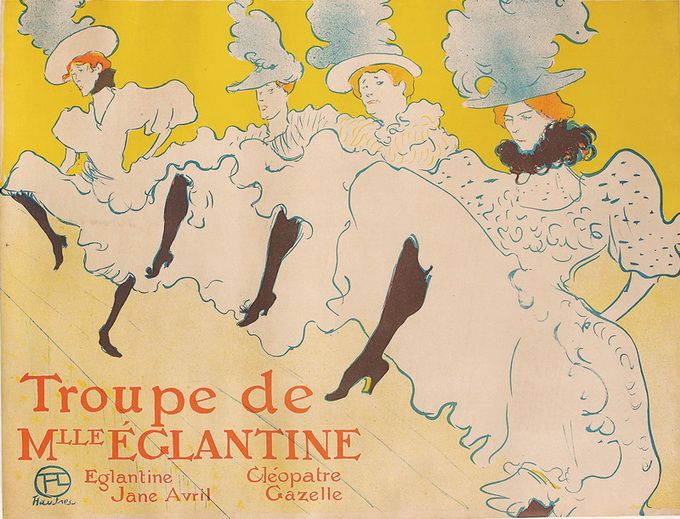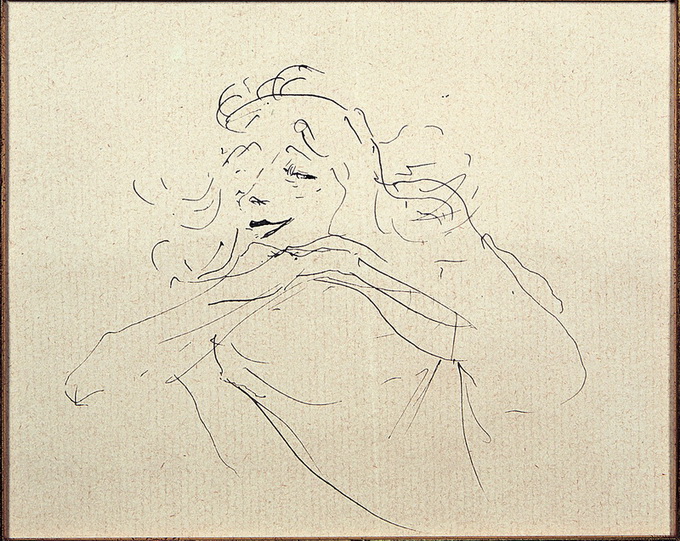 |
Toulouse Lautrec - La Ville Lumière |
| Paris, late 19th century: Bohemian lifestyle, the artists of Montmartre, the Moulin Rouge, theatres, satirical journals and prostitutes. This was the captivating world of Toulouse-Lautrec, a genius who primarily made his name through advertising posters and portraits of figures who characterised an era, making a real impression on the public imagination. |
| Related images (19) |
|
Paris, late 19th century: Bohemian lifestyle, the artists of Montmartre, the Moulin Rouge, theatres, satirical journals and prostitutes. This was the captivating world of Toulouse-Lautrec, a genius who primarily made his name through advertising posters and portraits of figures who characterised an era, making a real impression on the public imagination. Curated by Stefano Zuffi and with the patronage of Regione Sicilia - Assessorato regionale dei Beni Culturali e dell'Identità Siciliana, Toulouse Lautrec. La Ville Lumière is an exhibition promoted by Comune di Catania, produced and organized by Arthemisia in partnership with the Comune di Catania and with the collaboration of Herakleidon Museum in Athens. The initiative is promoted by Generali Italia – sponsor of the exhibition – through the Valore Cultura programme, a project that sets out to attract families, youths, clients, and employees to the world of art by offering reduced tickets to exhibitions, theatre shows, events, and art and culture related activities. The exhibition also counts on special partner Ricola and hotel partner UNA Hotel Palace. THE EXHIBITION After a number of detailed introductions to the artist and his period, the exhibition is divided into eleven thematic sections, all relating to the major historical, technological, social and architectural changes taking place in late 19th-century Paris, during the exciting Belle Époque.
Section one ‒ The study of engraving and lithography Section one introduces visitors to Toulouse-Lautrec’s greatest artistic passion: engraving, or lithography to be more precise. An exceptional series of works and items (preliminary drawings, lithographic stone, first print without writing, definitive version) make it possible to observe the creative process that led to the production of a famous engraving, destined to form the cover of a musical score: the figure shown in the image is the composer Desiré Dihau, who played the bassoon in the opera house orchestra and was related to Toulouse-Lautrec. We see him performing a bassoon solo in the lithograph Pour Toi!... (1893). This is followed by three sections devoted to the Parisian night scene, with a sequence of rooms focusing on the individual undisputed protagonists of the most famous French scenes of the late 19th century: Jane Avril, Aristide Bruant and Yvette Guilbert. Toulouse-Lautrec developed a friendship with the famous Parisian cabaret star Jane Avril (1868‒1943), to the point of immortalizing himself in a famous ironic photograph in which he is dressed in her clothes. The artist portrays her as a sophisticate attending a cafe-concert in the poster Divan Japonais (1893), but also shows her uninhibited can-can performance together with other dancers in La Troupe de Mlle Églantine (1896). One of the greatest admirers of Toulouse-Lautrec’s posters was the singer-songwriter and cabaret artist Aristide Bruant (1851‒1925): Henri portrays the singer in a series of prints and lithographs, including Aristide Bruant in his Cabaret (1893), where he shows him wearing a voluminous cloak, broad-brimmed hat and a red scarf around his neck. The modernity of these stylized illustrations, structured into expanses of homogeneous colour, made him an immediate and unexpected celebrity. The figure of Yvette Guilbert (1868‒1944), nicknamed La Diseuse (or the reciter), is unforgettable: the most distinctive feature of the scene are the long black gloves worn up to her elbow. Fascinated by the personality of the actress and singer, Toulouse-Lautrec devoted an album of lithographs to her, all of which are included in the exhibition, as well as various drawings and engravings (Album Yvette Guilbert, 1894). A very rare recording of a song performed by Guilbert (A l’hotel du numero trois) can also be heard in this room. Section five ‒ Drawings from adolescence to adulthood The central part of the exhibition features a series of pencil and pen drawings, which are strikingly contemporary and cuttingly incisive.
Section six – Satirical journals Publishing projects represent an important aspect of Toulouse-Lautrec's art. The rapid spread of illustrated journals shows how the Parisians of the Belle Époque had more and more time to devote to reading. The journaux humoristique, of which Le Rire was probably the most successful, focused on political satire, corruption and military scandals, together with gossip about high-profile figures, including the stars of the Parisian night scene. Section seven ‒ The Moulin Rouge and Parisian shows A section on the world of show business, from the Moulin Rouge to the opera house, devoted to the diverse scene of late 19th-century entertainment, from the popular cabaret to more challenging performances of Greek tragedies or concerts at the opera house. Toulouse-Lautrec said: “It doesn’t matter what show it is. I’m always happy at the theatre!", and his works devoted to the world of show business are always fascinating, conveying joy and pleasure. In his theatrical scenes, Lautrec manages to render the intensity of the dramas or the comedies by means of effective movements and dynamic contrasts of light and shadow that draw inspiration from Japanese woodcuts and Daumier’s theatre stages. The works on display include the series of witty lithographs produced in 1893 for Le café- concert collection. Section eight – Horses and riders His friend the publisher Thadée Natanson recalled: “Henri loved animals less than women but more than men. He was crazy about horses and never got over being unable to ride them.” Having grown up among the country aristocracy, Toulouse-Lautrec had a great passion for horses. The painter’s father, Count Alphonse, was a skilled horseman, a lover of the outdoor life who went out for long rides and hunting expeditions with his falcon. Some of the drawings in this section date to his adolescence, demonstrating the artist’s extraordinary precocity. Section nine – Books and publishing projects After spending the night doing the rounds of the cafes and cabarets in Montmartre, Toulouse-Lautrec would get to work with unexpected energy and lucidity, working on several things at the same time. This can partly be attributed to his prodigious inventive and creative speed, but also his passion for printing, supervising all the phases himself. Because of this, as well as because of his advertising posters, the artist's talent was much in demand in the publishing sector, in satirical journals with an extensive readership but also prestigious books and covers for musical scores. A particular publishing project involved Toulouse-Lautrec in the illustrations for Au Pied du Sinaï, a collection of tales that describes – sometimes with black humour – life in the Jewish communities in various European countries. The author was Georges Clemenceau, future president of the French Republic. In 1897, Toulouse-Lautrec produced the lithographs for the cover and the illustrations. The luxury edition contained ten lithographs, each printed four times on different paper, and four additional lithographs Section ten – La Revue Blanche This part of the exhibition is devoted to Toulouse-Lautrec’s intellectual acquaintances: his relationships with poets, publishers and wealthy patrons is, in a certain sense, the other side to the Bohemian artist, lost in the glasses of absinthe of Parisian nights. Much of Paris’ social life unfolded in the offices and homes of the editors of La Revue Blanche and it was here that Toulouse-Lautrec forged various friendships with writers and scholars. In 1895 he designed a poster for the magazine (La Revue Blanche, 1895), featuring the fascinating Misia Natanson, the editor's wife. Section eleven – Toulouse and women Parisian life at the turn of the century took place under the satirical eye of Toulouse-Lautrec: dances, performances, evening entertainments, lights, theatres, laughter and applause, thanks to cabaret artists, dancers and chansonniers. But this represents just part of the painter’s production. His portraits of single, silent women are perhaps even more intense and personal, observed without the least intention to produce a caricature or a cartoon. They are moments of reflection, clouds blowing across the soul, fleeting shadows passing over a face.
The exhibition concludes with the delicate works dedicated to this theme. No artist, prior to Toulouse- Lautrec, had succeeded in grasping the repressed passions, loneliness and desire for a better life concealed beneath the forced sensuality and “professional” seduction of singers, actresses and prostitutes, observed without irony or moralism. As in the case of contemporary French literature (from the novels of Flaubert to the short stories of Maupassant), subjects and characters usually deemed to be scandalous or immoral are redeemed by art. Toulouse-Lautrec liked the frivolous environment of the brothels and spent entire weeks in the maison closes near the opera house and the Paris stock exchange between 1892 and 1895. Here he watched the girls for hours, at rest, playing cards or putting on their make-up. What is more, he did not have to be ashamed of his appearance in their company. The uninhibited spontaneity of these women made them ideal models in his eyes. The most complete cycle consists of the colour lithographs from the Elles (Them) of 1896, masterpieces of French late 19th-century engraving. The exhibition features the frontispieces and the wonderful lithograph Woman at her Toilette. Among the female images evoked by Toulouse-Lautrec we can also observe the dream of an impossible love, the mysterious lady encountered on a ship and evoked with great delicacy in the lithograph entitled The Passenger in Cabin 54 (1896) Exhibition venue Palazzo della Cultura Opening times Monday to Sunday 10 a.m. to 8 p.m. (the ticket office closes an hour earlier) Tickets Full price € 13.00 (audio guide included) Concessions € 11.00 (audio guide included) Info and bookings T. + 39 095 883 791 Herakleidon Museum, Athens, Greece PAN Art Connections Inc. www.pan-art-connections.com | |

 Munch: The Scream Within
Munch: The Scream WithinOne of the year’s most eagerly awaited exhibitions to open its doors on 14 September 2024: Edvard Munch is back in Milan with a major retrospective after a 40-year absence.
 In the garden
In the gardenThe initiative, which is scheduled to run from June 26th to September 13th, 2020, is inaugurating a temporary space for art in Corso Matteotti 5, in Milan, in the very heart of the city.
 Perugia Travel Guide
Perugia Travel GuidePerugia is the chief town of Umbria. This beautiful town is sited on a hill in the middle of a verdant country. His central square is considered one of the most beautiful squares of Italy and history, traditions, art and nature make a unique ensemble in this town as in the whole




